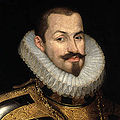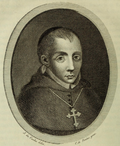| Picture | Viceroy | From | Until | Monarch |
|---|
|
 | Fernando Álvarez de Toledo, 3rd Duke of Alba | 18 July 1580 | 11 December 1582 | 
Philip I of Portugal |
 | Albert VII, Archduke of Austria | 11 February 1583 | 5 July 1593 |
 | 1st Regency Council
Presided by Miguel de Castro, Archbishop of Lisbon
João da Silva, 4th Count of Portalegre
Francisco de Mascarenhas, 1st Count of Santa Cruz
Duarte de Castelo Branco, 1st Count of Sabugal
Miguel de Moura | 5 July 1593 | 1598 |
 | Francisco Gómez de Sandoval, 1st Duke of Lerma | 1598 | 29 January 1600 | 
Philip II of Portugal |
 | Cristóvão de Moura, 1st Marquis of Castelo Rodrigo | 29 January 1600 | 1603 |
 | Afonso de Castelo Branco, Bishop-Count of Coimbra | 1603 | 24 May 1605 |
 | Pedro de Castilho, Bishop of Leiria | 24 May 1605 | February 1608 |
 | Aleixo de Menezes, Archbishop-Primate of Braga | 1612 | 1615 |
 | Miguel de Castro, Archbishop of Lisbon | 1615 | 10 May 1619 |
 | Diogo da Silva e Mendonça, 1st Marquis of Alenquer | 10 May 1619 | 1 September 1621 |
 | 2nd Regency Council
Presided by Martim Afonso Mexia, Bishop-Count of Coimbra
Diogo de Castro, 2nd Count of Basto
Nuno Álvares Pereira Colón de Portugal, 3rd Duke of Veragua | 1 September 1621 | 30 August 1623 | 
Philip III of Portugal |
 | 3rd Regency Council
Presided by Diogo de Castro, 2nd Count of Basto
Afonso Furtado de Mendonça, Archbishop of Lisbon
Diogo da Silva, 5th Count of Portalegre | 30 August 1623 | 1631 |
 | 4th Regency Council
Presided by António de Ataíde, 5th Count of Castanheira
Nuno de Mendonça, 1st Count of Vale de Reis | 1631 | March 1632 |
 | António de Ataíde, 5th Count of Castanheira [1] | March 1632 | 12 May 1633 |
 | João Manuel de Ataíde, Archbishop of Lisbon | 12 May 1633 | 4 July 1633 |
 | Diogo de Castro, 2nd Count of Basto | 4 July 1633 | 23 December 1634 |
 | Margaret of Savoy, Duchess of Mantua | 23 December 1634 | 1 December 1640 |












